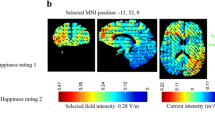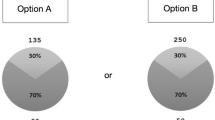Abstract
Reinforcement learning refers to the ability to acquire information from the outcomes of prior choices (i.e. positive and negative) in order to make predictions on the effect of future decision and adapt the behaviour basing on past experiences. The anterior prefrontal cortex (aPFC) is considered to play a key role in the representation of event value, reinforcement learning and decision-making. However, a causal evidence of the involvement of this area in these processes has not been provided yet. The aim of the study was to test the role of the orbitofrontal cortex in feedback processing, reinforcement learning and decision-making under uncertainly. Eighteen healthy individuals underwent three sessions of tDCS over the prefrontal pole (anodal, cathodal, sham) during a probabilistic learning (PL) task. In the PL task, participants were invited to learn the covert probabilistic stimulus-outcome association from positive and negative feedbacks in order to choose the best option. Afterwards, a probabilistic selection (PS) task was delivered to assess decisions based on the stimulus-reward associations acquired in the PL task. During cathodal tDCS, accuracy in the PL task was reduced and participants were less prone to maintain their choice after positive feedback or to change it after a negative one (i.e., win-stay and lose-shift behavior). In addition, anodal tDCS affected the subsequent PS task by reducing the ability to choose the best alternative during hard probabilistic decisions. In conclusion, the present study suggests a causal role of aPFC in feedback trial-by-trial behavioral adaptation and decision-making under uncertainty.



Similar content being viewed by others
Abbreviations
- aPFC:
-
Anterior prefrontal cortex
- vmPFC/mOFC:
-
Ventromedial prefrontal cortex/medial orbitofrontal cortex
- tDCS:
-
Transcranial direct current stimulation
References
Bechara, A., Damasio, A. R., Damasio, H., & Anderson, S. W. (1994). Insensitivity to future consequences following damage to human prefrontal cortex. Cognition, 50, 7–15.
Bechara, A., Damasio, H., & Damasio, A. R. (2000). Emotion, decision making and the orbitofrontal cortex. Cerebral Cortex, 10, 295–307.
Boggio, P. S., Sultani, N., Fecteau, S., Merabet, L., Mecca, T., Pascual-Leone, A., Basaglia, A., & Fregni, F. (2008). Prefrontal cortex modulation using transcranial DC stimulation reduces alcohol craving: a double-blind, sham-controlled study. Drug and Alcohol Dependence, 92, 55–60.
Camille, N., Tsuchida, A., & Fellows, L. K. (2011). Double dissociation of stimulus-value and action-value learning in humans with orbitofrontal or anterior cingulate cortex damage. The Journal of Neuroscience, 31, 15048–15052.
Chib, V. S., Yun, K., Takahashi, H., & Shimojo, S. (2013). Noninvasive remote activation of the ventral midbrain by transcranial direct current stimulation of prefrontal cortex. Trans Psychiatry, 3, e268.
Elliott, R., Newman, J. L., Longe, O. A., & Deakin, J. W. (2003). Differential response patterns in the striatum and orbitofrontal cortex to financial reward in humans: a parametric functional magnetic resonance imaging study. The Journal of Neuroscience, 23, 303–307.
Elliott, R., Agnew, Z., & Deakin, J. F. (2010). Hedonic and informational functions of the human orbitofrontal cortex. Cerebral Cortex, 20, 198–204.
Evenden, J. L., & Robbins, T. W. (1983). Dissociable effects of d-amphetamine, chlordiazepoxide and alpha-flupenthixol on choice and rate measures of reinforcement in the rat. Psychopharmacology, 79, 180–186.
Fecteau, S., Fregni, F., Boggio, P. S., Camprodon, J. A., & Pascual-Leone, A. (2010). Neuromodulation of decision-making in the addictive brain. Substance Use & Misuse, 45, 1766–1786.
Fellows, L. K., & Farah, M. J. (2003). Ventromedial frontal cortex mediates affective shifting in humans: evidence from a reversal learning paradigm. Brain, 126, 1830–1837.
Fellows, L. K., & Farah, M. J. (2007). The role of ventromedial prefrontal cortex in decision making: judgment under uncertainty or judgment per se?. Cerebral Cortex, 17(11), 2669–2674.
Ferrucci, R., Bortolomasi, M., Fumagalli, M., Giacopuzzi, M., Mameli, F., Priori, A., Scelzo, E., & Vergari, M. (2013). Transcranial direct current stimulation (tDCS): a treatment for depressive illness. Int Journ Psychiatry Clinic Practic, 15, 22–23.
Frank, M. J. (2005). Dynamic dopamine modulation in the basal ganglia: a neurocomputational account of cognitive deficits in medicated and non-medicated parkinsonism. Journal of Cognitive Neuroscience, 17, 51–72.
Frank, M. J., & Claus, E. D. (2006). Anatomy of decision: striato-orbitofrontal interactions in reinforcement learning, decision making and reversal. Psychological Review, 113, 300–326.
Frank, M. J., & Kong, L. (2008). Learning to avoid in older age. Psychology and Aging, 23, 392–398.
Frank, M. J., Seeberger, L. C., & O’Reilly, R. C. (2004). By carrot or by stick: cognitive reinforcement learning in parkinsonism. Science, 306, 1940–1943.
Fregni, F., Orsati, F., Pedros, W., Fectea, S., Tome, F. A., Nitsch, M. A., Mecca, T., Macedo, E., Pascual-Leon, A., & Boggio, P. S. (2008). Transcranial direct current stimulation of the prefrontal cortex modulates the desire for specific foods. Appetite, 51, 34–41.
Fumagalli, M., Vergari, M., Pasqualetti, P., Marceglia, S., Mameli, F., Ferrucci, R., Mrakic-Sposta, S., Zago, S., Sartori, G., Pravettoni, G., Barbieri, S., Cappa, S., & Priori, A. (2010). Brain switches utilitarian behavior: does gender make the difference? PloS One, 5(1), e8865.
Gozli, D. G., Moskowitz, J. B., & Pratt, J. (2014). Visual attention to features by associative learning. Cognition, 133, 488–501.
Jacobson, L., Koslowsky, M., & Lavidor, M. (2012). tDCS polarity effects in motor and cognitive domains: a meta-analytical review. Experimental Brain Research, 216, 1–10.
Jasper, H. H. (1958). The ten–twenty electrode system of the international federation. Electroencephalography and Clinical Neurophysiology, 10, 371–375.
Karim, A. A., Schneider, M., Lotze, M., Veit, R., Sauseng, P., Braun, C., & Braibaumer, N. (2010). The truth about lying: inhibition of the anterior refrontal cortex improves deceptive behavior. Cerebral Cortex, 20, 205–213.
Knutson, B., & Bossaerts, P. (2007). Neural antecedents of financial decisions. The Journal of Neuroscience, 27, 8174–8177.
Kringelbach, M. L., & Rolls, E. T. (2003). Neural correlates of rapid context-dependent reversal learning in a simple model of human social interaction. NeuroImage, 20, 1371–1383.
Kringelbach, M. L., & Rolls, E. T. (2004). The functional neuroanatomy of the human orbitofrontal cortex: evidence from neuroimaging and neuropsychology. Progress in Neurobiology, 72, 341–372.
Kringelbach, M. L., O’Doherty, J., Rolls, E. T., & Andrews, C. (2003). Activation of the human orbitofrontal cortex to a liquid food stimulus is correlated with its subjective pleasantness. Cerebral Cortex, 13, 1064–1071.
Kringelback, M. L. (2005). The human orbitofrontal cortex: linking reward to hedonic experience. Nature Reviews. Neuroscience, 6, 691–702.
Levasseur-Moreau, J., & Fecteau, S. (2012). Translational application of neuromodulation of decision-making. Brain Stimulation, 5, 77–83.
Liu, X., Powell, D. K., Wang, H., Gold, B. T., Corbly, C. R., & Joseph, J. E. (2007). Functional dissociation in frontal and striatal areas for processing of positive and negative reward information. The Journal of Neuroscience, 27, 4587–4597.
Loo, C. K., Alonzo, A., Martin, D., Mitchell, P. B., Galvez, V., & Sachdev, P. (2012). Transcranial direct current stimulation for depression: 3-week, randomised, sham-controlled trial. British J Psychiatry, 20, 52–59.
Ly, V., Bergmann, T. O., Gladwi, T. E., Volman, I., Usberti, N., Cools, R., & Roelofs, K. (2016). Reduced affective biasing of instrumental action with tDCS over the prefrontal cortex. Brain Stimulation, 9, 380–387.
Manuel, A. L., David, A. W., Bikson, M., & Schinder, A. (2014). Frontal tDCS modulates orbitofrontal reality filtering. Neuroscience, 265, 21–27.
Marin, M. F., Camprodon, J. A., Dougherty, D. D., & Mohammed, R. M. (2014). Device-based brain stimulation to augment fear extinction: implications for PTSD treatment and beyond. Depression and Anxiety, 31, 269–278.
Nitsche, M. A., & Paulus, W. (2001). Sustained excitability elevations induced by transcranial DC motor cortex stimulation in humans. Neurology, 57, 1899–1901.
Nitsche, M. A., Liebetanz, D., Anta, A., Lang, N., Tergau, F., & Paulus, W. (2003). Modulation of cortical excitability by weak direct current stimulation—technical, safety and functional aspects. Supplements to Clinical Neurophysiology, 56, 255–276.
Noonan, M. P., Walton, M. E., Behrens, T. E., Sallet, J., Buckley, M. J., & Rushworth, M. F. (2010). Separate value comparison and learning mechanisms in macaque medial and lateral orbitofrontal cortex. Proceedings of the National Academy of Sciences of the United States of America, 107, 20547–20552.
Noonan, M. P., Kolling, N., Walton, M. E., & Rushworth, M. F. (2012). Re-evaluating the role of the orbitofrontal cortex in reward and reinforcement. The European Journal of Neuroscience, 35, 997–1010.
O’Doherty, J., Kringelbach, M. L., Rolls, E. T., Hornak, J., & Andrews, C. (2001). Abstract reward and punishment representations in the human orbitofrontal cortex. Nature Neuroscience, 4, 95–102.
Ott, D. V., Ullsperger, M., Jocham, G., Neumann, J., & Klein, T. A. (2011). Continuous theta-burst stimulation (cTBS) over the lateral prefrontal cortex alters reinforcement learning bias. NeuroImage, 57, 617–623.
Reato, D., Gasca, D., Datta, A., Bikson, M., Marshall, L., & Parra, L. C. (2013). Transcranial electrical stimulation accelerates human sleep homeostasis. PLoS Computational Biology, 9(2), e1002898. doi:10.1371/journal.pcbi.1002898.
Rolls, E. T., & Grabenhorst, F. (2008). The orbitofrontal cortex and beyond: from affect to decision-making. Progress in Neurobiology, 86, 216–244.
Rolls, E. T., Hornak, J., Wade, D., & McGrath, J. (1994). Emotion-related learning in patients with social and emotional changes associated with frontal lobe damage. Journal of Neurology, Neurosurgery, and Psychiatry, 57, 1518–1524.
Rolls, E. T., Grabenhorst, F., & Deco, G. (2010). Choice, difficulty, and confidence in the brain. NeuroImage, 53, 694–706.
Rothermund, K., Wentura, D., & De Houwer, J. (2015). Retrieval of incidental stimulus-response associations as a source of negative priming. Journal of Experimental Psychology. Learning, Memory, and Cognition, 3, 482–495.
Rushworth, M. F., Noonan, M. P., Boorman, E. D., Walton, M. E., & Behrens, T. E. (2011). Frontal cortex and reward-guided learning and decision-making. Neuron, 70, 1054–1069.
Seymour, B., Daw, N., Dayan, P., Singer, T., & Dolan, R. (2007). Differential encoding of losses and gains in the human striatum. The Journal of Neuroscience, 27, 4826–4831.
Small, D. M., Zatorre, R. J., Dagher, A., Evans, A. C., & Jones-Gotman, M. (2001). Changes in brain activity related to eating chocolate: from pleasure to aversion. Brain, 124, 1720–1733.
Tsuchida, A., Doll, B. D., & Fellows, K. F. (2010). Beyond reversal: a critical role for human orbitofrontal cortex in flexible learning from probabilistic feedback. The Journal of Neuroscience, 30, 16868–16875.
Turi, Z., Mittner, M., Opitz, A., Popkes, M., Paulus, W., & Antal, A. (2015). Transcranial direct current stimulation over the left prefrontal cortex increases randomness of choice in instrumental learning. Cortex, 63, 145–154.
Volpato, C., Piccione, F., Cavinato, M., Duzzi, D., Schiff, S., Foscolo, L., & Venneri, A. (2013). Modulation of affective symptoms and resting state activity by brain stimulation in a treatment-resistant case of obsessive-compulsive disorder. Neurocase, 19, 360–370.
Volpato, C., Schiff, S., Facchini, S., Silvoni, S., Cavinato, M., Piccione, F., Antonini, A., & Birbaumer, N. (2016). Dopaminergic medication modulates learning from feedback and error-related negativity in Parkinson’s disease: a pilot study. Frontiers in Behavioral Neuroscience. doi:10.3389/fnbeh.2016.00205.
Wallis, J. D. (2007). Orbitofrontal cortex and its contribution to decision-making. Annual Review of Neuroscience (Palo Alto, CA), 30, 31–56.
Walton, M. E., Behrens, T. E., Noonan, M. P., & Rushworth, M. F. (2011). Giving credit where credit is due: orbitofrontal cortex and valuation in an uncertain world. Annals of the New York Academy of Sciences, 1239, 14–24.
Wheeler, E., & Fellows, L. K. (2008). The human ventromedial frontal lobe is critical for learning from negative feedback. Brain, 131, 1323–1331.
Acknowledgements
The authors are grateful to Esmeralda Balistreri, Gloria Imperato, and Daniele Aprile for participants’ recruitment and data collection.
Author information
Authors and Affiliations
Corresponding author
Ethics declarations
All the participants took part in the experiment voluntarily, after providing written informed consent. The University Hospital of Padua Ethical Committee approved the experimental procedure.
Rights and permissions
About this article
Cite this article
Casula, E.P., Testa, G., Bisiacchi, P.S. et al. Transcranial Direct Current Stimulation (tDCS) of the Anterior Prefrontal Cortex (aPFC) Modulates Reinforcement Learning and Decision-Making Under Uncertainty: a Double-Blind Crossover Study. J Cogn Enhanc 1, 318–326 (2017). https://doi.org/10.1007/s41465-017-0030-7
Received:
Accepted:
Published:
Issue Date:
DOI: https://doi.org/10.1007/s41465-017-0030-7




